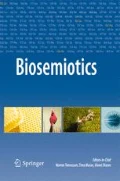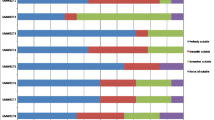Abstract
There is renewed interest in questions of ontology in various fields, as there has been in biosemiotics. But for umwelt theory, ontology needs to be approached in particular ways, in order to avoid it from being yet another “philosophy of access”, part and parcel of the epistemology-ontology dyad, where “ontology” is the leftover of epistemology, or any sort of subjective constitution of things. The article engages in philosophical considerations about what kinds of assumptions and preliminary considerations should be made for a semiosic ontology that was multiple, relational, and irreducible, with the principle goal being to engage with some terminological issues at the meeting point of ontology and umwelt theory. Ontography is proposed as a name for a low-key descriptive engagement with non-human umwelts considered as “worldings”, and maieutics as a particular attitude, or ethos, for the practical situation of direct inaccessibility of nonhuman umwelts. Parallels are drawn with the ontological turn in anthropology, which has also successfully engaged with alterity. A comparative study of umwelts should consider the ontological self-determination of the nonhuman other.
Similar content being viewed by others
Notes
Ontology as the “study of what is” and meta-ontological commitment are purportedly different; yet since the entire truth of ontological claims is made dependent on claims of a theory, this distinction remains a paradigmatic example of a “philosophy of access” (Harman, 2005) where the entirety of an explanation remains on the side of “representation” (broadly construed), and can thus be considered irrelevant for present purposes.
With a nod to all the sea urchins and others like them, whose legs move the animal and not the other way around, this transformation should probably be limited to creatures with a central nervous system, at least for the time being.
Latour himself considers phenomenoloy to be last great dying gasp of the Modern Synthesis—a “tightrope walker doing the splits” (ibid.: 59)—but this need not concern us in this limited discussion. Umwelts are sets of relations, they are indeed “over the middle”—but with the corollary that since they are constitutive relations, the relata do not exist in the same shape and form independently of the relations as they do as part of the relations.
References
Agamben, G. (2004). The Open: Man and Animal. Stanford, California: Stanford University Press
Bentley, A. F. (1941). The Human Skin: Philosophy’s Last Line of Defense. Philosophy of Science, 8, 1–19. https://doi.org/10.1086/286664
Berger, A. E., & Segarra, M. (2011). Demenageries: Thinking (of) Animals after Derrida. Amsterdam New York: Rodopi
Berger, J. (1980). About Looking. New York: Pantheon Books
Brentari, C. (2015). Jakob von Uexküll: The Discovery of the Umwelt between Biosemiotics and Theoretical Biology. Dordrecht Heidelberg: Springer
Buchanan, B. (2008). Onto-Ethologies: The Animal Environments of Uexküll, Heidegger, Merleau-Ponty, and Deleuze. Albany, NY: SUNY Press
Calarco, M. (2011). Identity, Difference, Indistinction. CR: The New Centennial Review, 11(2), 41–60. https://doi.org/10.1353/ncr.2012.0008
Carrithers, M., Candea, M., Sykes, K., Holbraad, M., & Venkatesan, S. (2010). Ontology Is Just Another Word for Culture. Critique of Anthropology, 30, 152–200. https://doi.org/10.1177/0308275X09364070
Charbonnier, P., Salmon, G., & Skafish, P. (2016). Comparative Metaphysics: Ontology After Anthropology. Lanham: Rowman & Littlefield International
Cimatti, F. (2018). Bio-semiotic Ontology: The Philosophy of Giorgio Prodi. New York, NY: Springer Berlin Heidelberg
Connolly, W. E. (2013). The ‘New Materialism’ and the Fragility of Things. Millennium: Journal of International Studies, 41(3), 399–412. https://doi.org/10.1177/0305829813486849
Davis, W. M. (1902). Systematic Geography. Proceedings of the American Philosophical Society, 41(170), 235–259
Deleuze, G. (1991). [1953]). Empiricism and Subjectivity: An Essay on Hume’s Theory of Human Nature. New York: Columbia University Press
Deleuze, G., & Guattari, F. (1994). What is philosophy?. New York: Columbia University Press
Descola, P. (2007). Beyond Nature and Culture. Proceedings of the British Academy, 139, 137–155. https://doi.org/10.5871/bacad/9780197263945.001.0001
Descola, P. (2013). Beyond Nature and Culture. Chicago; London: The University of Chicago Press
Descola, P. (2014). Modes of being and forms of predication. Hau: Journal of Ethnographic Theory, 4(1), 271–280. https://doi.org/10.14318/hau4.1.012
Favareau, D. (2015). Symbols are Grounded not in Things, but in Scaffolded Relations and their Semiotic Constraints (Or How the Referential Generality of Symbol Scaffolding Grows Minds). Biosemiotics, 8, 235–255. https://doi.org/10.1007/s12304-015-9234-3
Geertz, C. (1973). The Interpretation of Cultures. New York: Basic Books
Greif, M. (2015). The Age of the Crisis of Man. Thought and Fiction in America, 1933–1973. Princeton and Oxford: Princeton University Press
Harman, G. (2005). Guerrilla Metaphysics: Phenomenology and the Carpentry of Things. Chicago: Open Court
Hartmann, N. (2012). [1923]). How Is Critical Ontology Possible? Toward the Foundation of the General Theory of the Categories, Part One. Axiomathes, 22, 315–354. https://doi.org/10.1007/s10516-012-9183-2
Hendlin, Y. H. (in press). Object-Oriented Ontology and the Other of We in Anthropocentric Posthumanism
Herbrechter, S. (2018). Critical Posthumanism. In R. Braidotti, & M. Hlavajova (Eds.), Posthuman Glossary. London, New York: Bloomsbury Academic
Holbraad, M. (2009). Ontography and Alterity: Defining Anthropological Truth. Social Analysis, 53(2), 80–93. https://doi.org/10.3167/sa.2009.530205
Holbraad, M., & Pedersen, M. A. (2017). The Ontological Turn: An Anthropological Exposition. Cambridge, New York: Cambridge University Press
Kirksey, E. (2015). Emergent Ecologies. Durham: Duke University Press
Kroeber, A. (1917). The Superorganic. American Anthropologist, 19(2), 163–213
Kull, K. (2014). Zoosemiotics is the study of animal forms of knowing. Semiotica, 198, 47–60. https://doi.org/10.1515/sem-2013-0101
Kull, K., Emmeche, C., & Favareau, D. (2008). Biosemiotic Questions. Biosemiotics, 1, 41–55. https://doi.org/10.1007/s12304-008-9008-2
Latour, B. (1988). The Pasteurization of France. Cambridge, Mass.: Harvard University Press
Latour, B. (1993). We Have Never Been Modern. Cambridge, Massachusetts: Harvard University Press
Lynch, M. (2013). Ontography: Investigating the production of things, deflating ontology. Social Studies of Science, 43(3), 444–462. https://doi.org/10.1177/0306312713475925
Marchesini, R. (2017). Over the Human: Post-humanism and the Concept of Animal Epiphany. Cham, Switzerland: Springer
Meacham, D. (2016). How Low Can You Go? BioEnactivism, Cognitive Biology and Umwelt Ontology. Humana Mente Journal of Philosophical Studies, 31, 73–95
Nagel, T. (1974). What Is It Like to Be a Bat? The Philosophical Review, 83(4), 435–450
Nietzsche, F. (2001). [1882]). The Gay Science. With a Prelude in German Rhymes and an Appendix of Songs. Cambridge: Cambridge University Press
Plato, T. In: Complete Works, J. M. Cooper (Ed.), Indianapolis:Hackett
Pollner, M. (1987). Mundane Reason: Reality in Everyday and Sociological Discourse. Los Angeles: University of California
Quine, W. V. O. (1948). On What There Is. The Review of Metaphysics, 2(1), 21–38
Rayo, A. (2007). Ontological Commitment. Philosophy Compass, 2(3), 428–444. https://doi.org/10.1111/j.1747-9991.2007.00080.x
Rosen, R. (2000). Essays on Life Itself. New York: Columbia University Press
Shaw, I. G. R., Jones, J. P., & Butterworth, M. K. (2013). The mosquito’s umwelt, or one monster’s standpoint ontology. Geoforum, 48, 260–267. https://doi.org/10.1016/j.geoforum.2012.11.028
Stjernfelt, F. (2007). Diagrammatology: An Investigation on the Borderlines of Phenomenology, Ontology, and Semiotics. Dordrecht London: Springer
Viveiros de Castro, E. (1998). Cosmological Deixis and Amerindian Perspectivism. The Journal of the Royal Anthropological Institute, 4(3), 469–488. https://doi.org/10.2307/3034157
de Viveiros, E. (2014). Cannibal Metaphysics: For a Post-structural Anthropology. Minneapolis: Univocal Publishing
de Viveiros, E. (2015a). The Relative Native: Essays on Indigenous Conceptual World. Chicago, IL: HAU Books
de Viveiros, E. (2015b). Who Is Afraid of the Ontological Wolf? Some Comments on an Ongoing Anthropological Debate. The Cambridge Journal of Anthropology, 33(1), 2–17. https://doi.org/10.3167/ca.2015.330102
von Uexküll, J. (1926). Theoretical Biology. New York: Harcourt, Brace & Company, Inc.
von Uexküll, J. (2010). [1934]). A Foray into the Worlds of Animals and Humans with A Theory of Meaning. Minneapolis: University of Minnesota Press
Whitehead, A. N. (2015). [1920]). The Concept of Nature. Cambridge: Cambridge University Press
Wolfe, C. (2010). What is Posthumanism?. Minneapolis, London: University of Minneapolis Press
Acknowledgements
This paper was written with the support of the Estonian Research Council grant PRG314 “Semiotic fitting as a mechanism of biocultural diversity: instability and sustainability in novel environments”.
Author information
Authors and Affiliations
Corresponding author
Ethics declarations
Competing interests
The author declares that there are no conflicts of interest.
Additional information
Publisher’s Note
Springer Nature remains neutral with regard to jurisdictional claims in published maps and institutional affiliations.
Rights and permissions
About this article
Cite this article
Rattasepp, S. Ontography and Maieutics, or Speculative Notes on an Ethos for Umwelt Theory. Biosemiotics 15, 357–372 (2022). https://doi.org/10.1007/s12304-022-09492-w
Received:
Revised:
Accepted:
Published:
Issue Date:
DOI: https://doi.org/10.1007/s12304-022-09492-w




